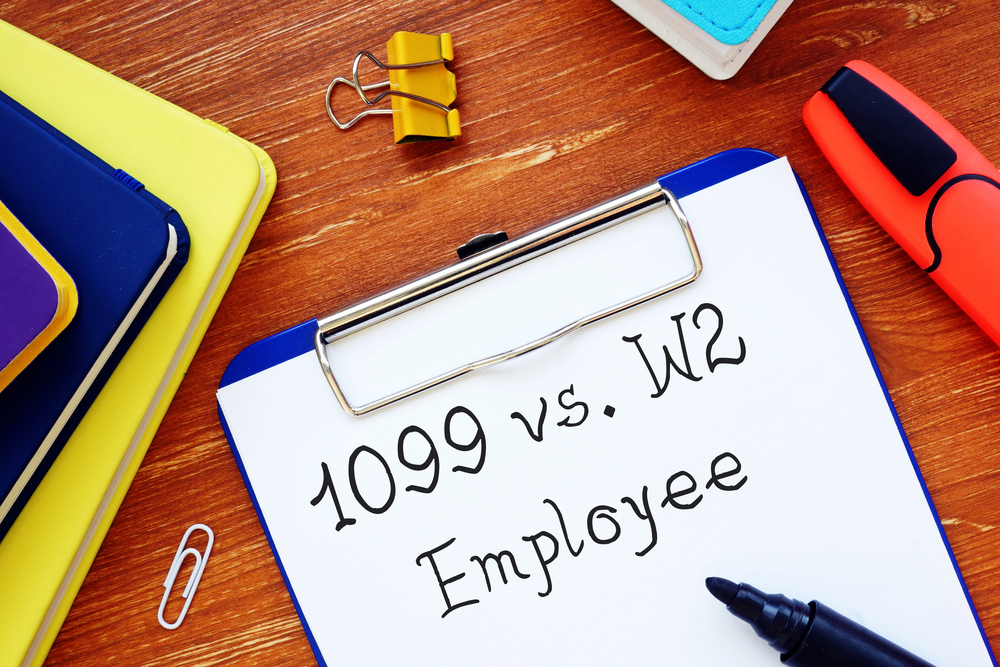

Why misclassifying caregivers and homecare employees as 1099 contractors is a dangerous gamble—and what homecare business owners need to know about proper worker classification
In the competitive homecare industry, every dollar counts. With tight margins and increasing operational costs, it’s tempting to look for shortcuts to reduce expenses. One of the most dangerous shortcuts? Misclassifying caregivers and homecare employees as independent contractors to avoid payroll taxes, benefits, and compliance requirements.
What seems like smart cost-cutting today can become a catastrophic business decision tomorrow. The reality is stark: misclassifying caregivers and homecare employees isn’t just risky—it’s a ticking time bomb that can destroy your homecare business, your reputation, and your ability to serve the vulnerable populations who depend on you.

Caregivers and Homecare Employees Misclassification: Understanding the Scope
Worker misclassification has reached epidemic proportions across industries, but the homecare sector faces unique challenges. Federal, state, and local labor laws provide extensive protections for employees, including the minimum wage, overtime pay, eligibility for state and federal unemployment insurance, Workers’ Compensation coverage, and employer contributions toward Social Security and Medicare. Many employers, however, exploit the gray areas and unclear spots in current government regulations to avoid contributing their share toward these worker protections by misclassifying some of their workers as independent contractors rather than as employees.
The homecare industry’s structure makes it particularly vulnerable to misclassification issues. Caregivers often work in clients’ homes, operate with some degree of independence, and may work flexible schedules. These factors can create confusion about proper classification, but they don’t change the fundamental legal requirements.
Understanding the Classification Test
The determination between employee and contractor isn’t based on what you call someone or how you pay them. Receiving a 1099 tax form is simply the result of how your employer classifies you for federal tax purposes, but the form itself does not mean you are correctly classified as an independent contractor.
Instead, classification depends on the reality of the working relationship. The IRS uses three primary factors:
For most homecare situations, these factors clearly point to an employee relationship. If you’re scheduling shifts, providing uniforms or equipment, training caregivers on client-specific needs, or directing how care is delivered, you’re describing an employee, not a contractor.
Real-World Consequences: When Classification Goes Wrong
The consequences of misclassification extend far beyond theoretical fines. Workers who believe they were not paid correctly can file a complaint. They have up to two years for regular mistakes and up to three years if the employer knowingly violated the rules. For caregivers misclassified as independent contractors, employers may also face penalties for failing to withhold and remit state and federal payroll taxes, including failure to make Social Security and Medicare tax payments.
Case Study: The $4.5 Million Wake-Up Call
A federal court ordered a home care agency to pay over $4.5 million in back wages and damages to 503 workers following a Department of Labor investigation. This case demonstrates the scale of financial devastation that misclassification can bring to a homecare business.
Let’s break down the real costs with a simple example. Imagine a medium-sized homecare agency with 100 workers who are wrongly classified as contractors. Each worker makes $15 per hour and works 30 hours per week:
Here’s the scary part: this isn’t just for one year. If the government finds out you knowingly broke the rules, they can go back three years. That means you could owe over $1 million in back taxes and penalties—and that’s before adding on late fees, interest charges, and lawyer costs.
The Ripple Effect: Beyond Financial Penalties
The consequences go way beyond just paying fines:
Government Trouble:
Your Business Gets Disrupted:
Your Reputation Takes a Hit:
Industry-Specific Risks for Homecare Providers
Homecare agencies face unique challenges that make misclassification particularly dangerous:
The Control Factor
Homecare providers typically exercise significant control over their workers:
This level of control strongly indicates an employee relationship, regardless of how payments are structured.
Safety and Liability Concerns
The misclassified worker has no workers’ compensation coverage, creating serious liability exposure. When a caregiver is injured while providing care, the agency faces potential direct liability for medical expenses, lost wages, and related damages—costs that would typically be covered by workers’ compensation insurance.
Professional Standards and Training
Homecare requires specific skills, training, and often certification. When agencies provide this training or require specific qualifications, it further strengthens the case for employee classification.
The False Economy: Why Short-Term Savings Become Long-Term Losses
Many homecare agencies are drawn to 1099 classification by the apparent cost savings:
But this thinking ignores the huge hidden costs and risks:
The Real Numbers Breakdown
What You Think You’re Saving (Per worker making $30,000/year):
What It Actually Costs You When You Get Caught:
The Bottom Line: Even if you think there’s only a 1-in-10 chance you’ll get caught, the math still doesn’t work out. You’d expect to lose $2,250-$9,000, which is more than the $3,800-$4,400 you thought you were saving. And here’s the kicker—government agencies are cracking down harder than ever, so your chances of getting caught are way higher than 10%.
The Enforcement Landscape: A Changing Environment
Government enforcement of classification laws has intensified significantly. The Department of Labor has made misclassification a priority enforcement area, conducting targeted investigations in high-risk industries including homecare.
Federal Enforcement Trends
Building a Compliant Business Model: The Right Way Forward
Proper classification isn’t just about avoiding penalties—it’s about building a sustainable, ethical business that attracts quality workers and provides excellent client care.

How to Do Things the Right Way
Why Doing It Right Actually Helps Your Business
Believe it or not, properly classifying workers can give you an edge over competitors:
Better Workers Want to Work for You:
Clients Trust You More:
Your Business Runs Smoother:
Technology Makes Following the Rules Easier
The good news? Modern technology can help homecare agencies stay compliant without drowning in paperwork or breaking the bank:
Smart Payroll and HR Systems
Companies like Payroll Medics specialize in helping healthcare businesses navigate these complex requirements, offering solutions designed specifically for agencies that need to get classification right the first time.
Better Record-Keeping
The key is finding technology partners who understand the unique challenges of homecare businesses and can provide solutions that actually make your life easier, not more complicated.
Industry Resources and Professional Guidance
Homecare agencies don’t have to navigate classification issues alone. Professional resources include:
Professional Help When You Need It
Companies like Payroll Medics go beyond basic payroll services to become true partners for homecare champions. They understand that homecare agencies face unique challenges—from managing caregivers who work in clients’ homes to navigating complex state regulations that vary by location. Rather than offering one-size-fits-all solutions, they provide specialized guidance on worker classification, help implement compliant payroll systems, and offer ongoing support to ensure agencies stay on the right side of changing regulations. For homecare business owners who want to focus on providing excellent care rather than worrying about compliance headaches, having a specialized partner can make all the difference.
Industry Organizations
Government Resources
The Path Forward: Making the Right Choice
The choice between proper employee classification and risky contractor misclassification isn’t really a choice at all—it’s a test of business judgment and ethical leadership. The apparent short-term savings of misclassification pale in comparison to the potential long-term costs, both financial and reputational.
Building a Business That Lasts
The best homecare agencies know that classifying workers correctly isn’t just an expense—it’s an investment that pays off:
The Bottom Line
Misclassification undermines businesses who play by the rules and basic worker protections like minimum wage, paid sick days, and the safety of workplaces. In an industry built on trust and care for vulnerable populations, cutting corners on basic employment obligations sends the wrong message to workers, clients, and regulators.
Conclusion: Choose Compliance, Choose Success
The homecare industry faces enough legitimate challenges without adding the unnecessary risk of worker misclassification. From rising healthcare costs to regulatory changes to workforce shortages, successful agencies need every advantage they can get.
Worker misclassification isn’t an advantage—it’s a liability that grows more dangerous every day. The smart money isn’t on avoiding compliance; it’s on embracing it as a foundation for sustainable business success.
The question isn’t whether you can afford to properly classify your workers. The question is whether you can afford not to. With enforcement increasing, penalties mounting, and competition intensifying, the agencies that thrive will be those that build their businesses on solid legal and ethical foundations.
Don’t let a penny-wise, pound-foolish approach to worker classification destroy everything you’ve built. The cost of doing things right is always less than the cost of doing things wrong—especially when the stakes are this high.
Your caregivers deserve proper classification and protection. Your clients deserve stable, professional service. Your business deserves a sustainable future. Make the right choice: classify correctly from day one, and build your homecare business to last.
Ready to ensure your homecare agency’s compliance? Consult with a friendly Payroll Medic and implement proper classification practices today. Your future self will thank you.